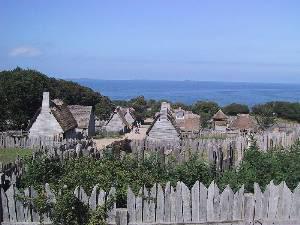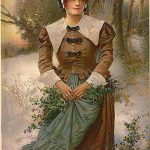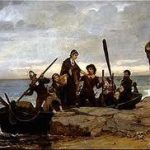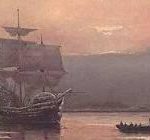First of the New England Colonies
Plymouth Colony Begins
The people we know as the Pilgrims have become so surrounded with legends and tales that we tend to forget that they were real people – but they were placed in extraordinary situations. And yes, they did wonderfully brave things. Basically, they were English people who had suffered persecution in their homeland, and were searching for a place where they could worship God as they chose.
On December 20, 1620, the Pilgrims dropped anchor in Plymouth Harbor. The spot they chose had been named “Plimouth” on a 1614 map made by Captain John Smith, and thus it was named. The men spent three days surveying for a settlement site. They finally decided on a recently abandoned Native American village named Patuxet, largely for its defensive position.
The settlement would be centered on two hills: Cole’s Hill, where the village would be built, and Fort Hill, where a defensive cannon would be stationed. And the local Native Americans had cleared much of the land, which would make planting relatively easy.
Due to a winter storm, everyone remained on the Mayflower for the following two days. And finally on December 23, the men began felling trees and collecting materials to build shelter for their families, returning each night to the ship. Women, children and the infirm remained on board the Mayflower; many had not left the ship for six months.
On January 1, 1621, the leaders of Plymouth Colony made land assignments by counting “how many families there were, willing all single men that had not wives to join with some family as they thought fit, that so we might build fewer houses; which was done and we reduced them to nineteen families,” wrote William Bradford. “We went to labor that day in the building of our town, in two rows of houses for more safety.”
The first structure, a “common house,” took two weeks to complete in the harsh New England winter. In the following weeks, the rest of the settlement slowly took shape. Many of the able-bodied men were too sick to work, and some died of their illnesses. Thus, only seven residences (of a planned nineteen) and four common houses were constructed during the first winter.
They surrounded the entire compound, which they called Plymouth Plantation, with a stockade fence. The first street in Plymouth Colony led from the harbor up the hill to the cannon. At the intersection of the first cross street stood the Governor’s house. Everyone had access to the brook where flagons were filled with drinking water, and where clothing was washed.
Plymouth Plantation
The soil wasn’t particularly fertile, and the early onset of winter made for a short growing season. So the colonists adopted Native American crops—maize, squash, pumpkins, beans, and potatoes. They learned farming techniques from the Wampanoag, such as proper crop rotation and the use of dead fish as fertilizer. They also planted Old World crops such as turnips, carrots, peas, wheat, barley, and oats.
Many of the Pilgrims turned to the sea to earn a living. They became fishermen, sailors, and merchants. They took cargoes of fish, timber, and surplus crops to the West Indies, to England, and to Spain, and brought back articles they couldn’t make at home. They harnessed waterpower and established grain mills and sawmills.
Plymouth Colony: 1622
The colonists continued to struggle through the winter. By May 1622 their food supply was completely gone and the harvest was four months away. Edward Winslow stated, “And indeed, had we not been in a place where divers sorts of shell fish may be taken with the hand, we must have perished.”
In desperation, Winslow was sent 150 miles up the Maine coast to buy, beg or borrow whatever provisions the English ships there could spare. All who were asked gave what they could, and not one would accept payment of any kind. By the time Winslow returned, the settlers were literally starving. The provisions were a Godsend but there were many mouths to feed. When rationed out, each person received only a quarter pound of bread a day.
Deadly Trickery
In May 1622, a ship named the Sparrow arrived at Plymouth Colony carrying seven men from the Merchant Adventurers whose purpose was to seek out a site for a new settlement in the area. Soon two more ships followed carrying sixty more men. These men spent July and August in Plymouth before moving north to settle at a place they named Wessagussett.
Responding to reports of a threat to Wessagussett, Miles Standish organized a militia to defend Wessagussett, but he found that there had been no attack. Still, he lured two prominent Native American Massachusett military leaders into a house at Wessagussett and killed them
Standish and his men pursued the local sachem, but he escaped with three English prisoners from Wessagusset, whom he then executed. Within a short time, Wessagussett was disbanded, and the survivors moved to Plymouth. News of Standish’s attack spread quickly among the Native Americans, and many Native Americans abandoned their villages and left the area.
In his 1624 memoirs, Good News from New England, Edward Winslow wrote that
“they forsook their houses, running to and fro like men distracted, living in swamps and other desert places, and so brought manifold diseases amongst themselves, whereof very many are dead.”
The fur trade dried up, and the Pilgrims lost their main source of income for paying off their debts to the Merchant Adventurers. Rather than strengthening their position, Standish’s raid had disastrous consequences for the colony.
A six-week drought began in June, and the crops turned brown. The Pilgrims turned to the only hope they hadintervention by Godand appointed a solemn day of humiliation and prayer. They assembled one July morning under a hot clear sky, and for nine hours, prayed. Their prayers were answered by the next morning, and for the next two weeks they were greeted, in the words of Winslow with “such soft, sweet and moderate showersit was hard to say whether our withered corn or drooping affections were most quickened and revived.”
A six-week drought began in June, and the crops turned brown. The Pilgrims turned to the only hope they had – intervention by God – and appointed a solemn day of humiliation and prayer. They assembled one July morning under a hot clear sky, and for nine hours, they prayed. Their prayers were answered by the next morning, and for the next two weeks they were greeted, in the words of Winslow with “such soft, sweet and moderate showers… it was hard to say whether our withered corn or drooping affections were most quickened and revived.”
John Pory, on board the Discovery, stopped at Plymouth on his way to England from Jamestown at the end of his three-year term as Secretary to the Governor and Council of Virginia. He left at the end of August 1622, and later described Plymouth Colony to the Earl of Southampton:
The town is seated on the ascent of a hill, which besides the pleasure of variable objects entertaining the unsatisfied eye, such is the wholesomeness of the place (as the Governor told me) that for the space of one whole year, of the two wherein they had been there, died not one man, woman or child.
This healthfulness is accompanied with much plenty both of fish and fowl every day in the year, as I know no place in the world that can match it. In March the eels come forth out of places where they lie bedded all winter, into the fresh streams, and there into the sea, and in their passages are taken in pots. They are passing sweet, fat and wholesome, having no taste at all of the mud, and are as great as ever I saw any.
In April & May come up another kind of fish which they call herring, or ‘old wives,’ in infinite schools into a small river running under the town, and so into a great pond or lake of a mile broad where they cast their spawn, the water of the said river being in many places not above half a foot deep.
About mid-way come into the harbor the many schools of bass and blue fish, which they take with skeins – some fishes of a foot and a half, some of two feet, and some of 3 feet long, and with hooks those of 4 and 5 feet long. They enter also at flowing water up into the small creeks, at the mouths whereof the inhabitants, spreading their nets, have caught 500 and 700 at a time. These continue good May, June, July and August.
Within 2 miles southward from their plantation do begin goodly ponds and lakes of fresh water, continuing well nigh 20 miles into the land, some with islands in them, the water being as clear as crystal, yielding great variety of fish. Muscles and clams they have all the year long.
Now as concerning the quality of the people, how happy were it for our people in the Southern Colony, if they were as free from wickedness and vice as these are in this place! And their industry as well appears by their building, as by a substantial palisade [a fence of wooden stakes and posts forming an enclosure] about their settlement of 2700 feet in compass, stronger than I have seen any in Virginia, and lastly by a blockhouse [fort], which they have erected in the highest place of the town to mount their ordnance [cannon] upon, from whence they may command all the harbor.
The long awaited harvest of 1622 was a dismal failure. The Pilgrims had been busy building the fort, which had left them too weak and weary to tend the fields properly. It seemed they now faced the prospect of another year with little food. Fortunately a deer, wild turkey, partridge or quail was occasionally killed.
Plymouth Colony: 1623
The Colony expanded slowly due to the infertility of the land and the lack of a staple moneymaking crop. By early 1623, they were using the shallop (a small boat they brought on the Mayflower) as a fishing vessel. It was constantly at sea, coming ashore only long enough to unload a catch and change crews. For months at a time, their diet consisted of fish, clams, groundnuts and whatever deer or water fowl that could be hunted.
In July and August, 1623, two more ships arrived, the Anne and Little James, bringing 60 more settlers, and a large store of welcome supplies – and carpenters, weavers and cobblers, who were greatly needed. Little James was to remain for the use of the colony. The Anne brought many Pilgrim wives and children who had been left behind until the colony was better established.
Notable among them was Alice Southworth, Barbara (missing surname), soon to become the wife of Captain Standish and Bridget Fuller, the wife of the doctor of Plymouth. Elizabeth Warren, with her five daughters, came to make a home for her husband, Richard. Hester Cooke came with three children. Fear and Patience Brewster brought great joy to their mother and girlhood friends.
Emmanuel Altham wrote a letter to his brother back in England in September 1623. Altham was one of the Merchant Adventurers who had invested in Plymouth Colony, and the captain of the Little James. This is his description of the colony:
It is well situated upon a high hill close unto the seaside, and very commodious for shipping to come unto them. In this plantation is about twenty houses, four or five of which are very fair and pleasant, and the rest shall be made better. Furthermore, here is belonging to the town six goats, about fifty hogs and pigs, also diverse hens. And lastly, the town is furnished with a company of honest men, that do, in what lies in them, to get profit to the adventurers.
1623 Division of Land
The communal system of labor – each person working for the common good – was abandoned because it was interfering with the production of food. Every colonist was allotted one acre of land, including women and children. Families were permitted to plant their own crops, to keep what they grew, and to trade their surplus.
They had very good success with this arrangement. The women now went willingly into the field, and took their little ones with them to plant corn. The young men no longer complained that they were spending their time and energy working for other men’s wives and children. The 1623 harvest proved to be the best yet.
SOURCES
Wikipedia: Plymouth Colony
History.com: Plymouth Colony
The Story of the Pilgrims V: After the First Year
A New Insight into the Early Settlement of Plymouth Plantation




